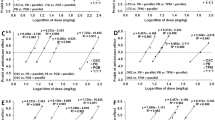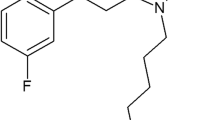Abstract
Combining the use of some antiepileptic drugs (AEDs) in patients with epilepsy can result in interactions of a pharmacodynamic or pharmacokinetic character. To quantify the profile of interactions between tiagabine (TGB) and gabapentin (GBP), two novel AEDs influencing the GABAergic neurotransmitter system, an isobolographic analysis was performed in the maximal electroshock seizure threshold (MEST), pentylenetetrazole (PTZ)-induced seizure and chimney tests in mice. TGB and GBP injected alone dose-dependently raised the electroconvulsive threshold in mice, which allowed the evaluation of TID20 (the dose increasing the threshold by 20% compared with controls) in the MEST-test. TID20 values for TGB and GBP alone were 4.3 mg/kg and 70 mg/kg, respectively. On the basis of isobolographic calculations, TGB was also co-administered with GBP at three fixed ratios (1:3, 1:1 and 3:1) of their respective TID20 doses. The isobolographic analysis showed that all three combinations of TGB with GBP exerted supra-additive (synergistic) interactions in the MEST-test in mice. Likewise, TGB and GBP injected alone suppressed the clonic phase of PTZ-induced seizures, with (effective) doses protecting 50% of the animals tested against clonic convulsions (ED50) for TGB and GBP of 0.9 and 199.3 mg/kg, respectively. Moreover, the two-drug combinations at the same fixed ratios of 1:3, 1:1 and 3:1 in PTZ-induced seizures also showed a tendency towards supra-additive (synergistic) interactions. The adverse (neurotoxic) effects produced by TGB and GBP alone or in combinations at the same fixed ratios of 1:3, 1:1 and 3:1 were evaluated in the chimney test. The (toxic) doses evoking motor impairment in 50% of animals tested (TD50) for TGB and GBP alone were 13.6 and 979.6 mg/kg, respectively. The isobolographic analysis showed the interactions between the AEDs to be additive in this test. From a preclinical point of view, the interactions observed experimentally showed that the combination of TGB and GBP, due to a synergistic anti-seizure activity of the drugs, might provide adequate seizure control in patients with refractory epilepsy.






Similar content being viewed by others
References
Berenbaum MC (1989) What is synergy? Pharmacol Rev 41:93–141 (Erratum p 422)
Boissier JR, Tardy J, Diverres JC (1960) Une nouvelle méthode simple pour explorer l’action tranquilisante: le test de la cheminée. Med Exp (Basel) 3:81–84
Borowicz KK, Swiader M, Luszczki J, Czuczwar SJ (2002) Effect of gabapentin on the anticonvulsant activity of antiepileptic drugs against electroconvulsions in mice—an isobolographic analysis. Epilepsia 43:956–963
Bourgeois BFD (1986) Antiepileptic drug combinations and experimental background: the case of phenobarbital and phenytoin. Naunyn-Schmiedeberg’s Arch Pharmacol 333:406–411
Bourgeois BFD (1988) Anticonvulsant potency and neurotoxicity of valproate alone and in combination with carbamazepine or phenobarbital. Clin Neuropharmacol 11:348–359
Bourgeois BFD (2002) Reducing overtreatment. Epilepsy Res 52:53–60
Brodie MJ (2001) Do we need any more new antiepileptic drugs? Epilepsy Res 45:3–6
Cadart M, Marchand S, Pariat C, Bouquet S, Couet W (2002) Ignoring pharmacokinetics may lead to isoboles misinterpretation: illustration with the norfloxacin-theophylline convulsant interaction in rats. Pharm Res 19:209–214
Czuczwar SJ, Borowicz KK (2002) Polytherapy in epilepsy: the experimental evidence. Epilepsy Res 52:15–23
Czuczwar SJ, Patsalos PN (2001) The new generation of GABA enhancers. Potential in the treatment of epilepsy. CNS Drugs 15:339–350
Czuczwar SJ, Przesmycki K (2001) Felbamate, gabapentin and topiramate as adjuvant antiepileptic drugs in experimental models of epilepsy. Pol J Pharmacol 53:65–68
Deckers CLP (2002) Overtreatment in adults with epilepsy. Epilepsy Res 52:43–52
Deckers CLP, Czuczwar SJ, Hekster YA, Keyser A, Kubova H, Meinardi H, Patsalos PN, Renier WO, van Rijn CM (2000) Selection of antiepileptic drug polytherapy based on mechanisms of action: the evidence reviewed. Epilepsia 41:1364–1374
Deckers CLP, Genton P, Sills GJ, Schmidt D (2003) Current limitations of antiepileptic drug therapy: a conference review. Epilepsy Res 53:1–17
Errante LD, Petroff OAC (1999) Effects of gabapentin on rat brain GABA, glutamate and glutamine. (abstract) Epilepsia 40 (Suppl. 7):19
Errante LD, Williamson A, Spencer DD, Petroff OA (2002) Gabapentin and vigabatrin increase GABA in the human neocortical slice. Epilepsy Res 49:203–210
Gasior M, Ungard JT, Witkin JM (1999) Preclinical evaluation of newly approved and potential antiepileptic drugs against cocaine-induced seizures. J Pharmacol Exp Ther 290:1148–1156
Gee NS, Brown JP, Dissanayake UK, Offord J, Thurlow R, Woodruff GN (1996) The novel anticonvulsant drug, gabapentin (neurontin), binds to the α2δ subunit of a calcium channel. J Biol Chem 271:5768–5776
Gessner PK (1995) Isobolographic analysis of interactions: an update on applications and utility. Toxicology 105:161–179
Goldlust A, Su T, Welty DF, Taylor CP, Oxender DL (1995) Effects of the anticonvulsant drug gabapentin on enzymes in the metabolic pathways of glutamate and GABA. Epilepsy Res 22:1–11
Gustavson LE, Mengel HB (1995) Pharmacokinetics of tiagabine, a gamma-aminobutyric acid-uptake inhibitor, in healthy subjects after single and multiple doses. Epilepsia 36:605–611
Holmes GL (2002) Overtreatment in children with epilepsy. Epilepsy Res 52:35–42
Kellinghaus C, Dziewas R, Lüdemann P (2002) Tiagabine-related non-convulsive status epilepticus in partial epilepsy: three case reports and a review of the literature. Seizure 11:243–249
Kerry DW, Hamilton-Miller JMT, Brumfitt W (1975) Trimethoprim and rifampicin: in vitro activities separately and in combination. J Antimicrob Chemother 1:417–427
Klitgaard H, Knudsen ML, Jackson HC (1993) Synergism between drugs with different mechanisms of action against audiogenic seizures in DBA/2 mice. (abstract) Epilepsia 34 (Suppl. 6):93–94
Kwan P, Brodie MJ (2000a) Epilepsy after the first drug fails: substitution or add-on? Seizure 9:464–468
Kwan P, Brodie MJ (2000b) Early identification of refractory epilepsy. New Eng J Med 342:314–319
Kwan P, Brodie MJ (2002) Refractory epilepsy: a progressive, intractable but preventable condition? Seizure 11:77–84
Leach JP (2000) Antiepileptic drugs: safety in numbers? Seizure 9:170–178
Leach JP, Brodie MJ (1994) Synergism with GABAergic drugs in refractory epilepsy. Lancet 343:1650
Leach JP, Sills GJ, Butler E, Forrest G, Thompson GG, Brodie MJ (1997) Neurochemical actions of gabapentin in mouse brain. Epilepsy Res 27:175–180
Litchfield JT, Wilcoxon F (1949) A simplified method of evaluating dose-effect experiments. J Pharmacol Exp Ther 96:99–113
Loewe S (1953) The problem of synergism and antagonism of combined drugs. Arzneimittelforschung 3:285–290
Löscher W (2002) Current status and future directions in the pharmacotherapy of epilepsy. Trends Pharmacol Sci 23:113–118
Löscher W, Nolting B (1991) The role of technical, biological and pharmacological factors in the laboratory evaluation of anticonvulsant drugs. IV. Protective indices. Epilepsy Res 9:1–10
Löscher W, Schmidt D (1988) Which animal models should be used in the search for new antiepileptic drugs? A proposal based on experimental and clinical considerations. Epilepsy Res 2:145–181
Löscher W, Schmidt D (2002) New horizons in the development of antiepileptic drugs. Epilepsy Res 50:3–16
Löscher W, Wauquier A (1996) Use of animal models in developing guiding principles for polypharmacy in epilepsy. Epilepsy Res Suppl 11:61–65
Löscher W, Fassbender CP, Nolting B (1991a) The role of technical, biological and pharmacological factors in the laboratory evaluation of anticonvulsant drugs. II. Maximal electroshock seizure models. Epilepsy Res 8:79–94
Löscher W, Hönack D, Fassbender CP, Nolting B (1991b) The role of technical, biological and pharmacological factors in the laboratory evaluation of anticonvulsant drugs. III. Pentylenetetrazole seizure models. Epilepsy Res 8:171–189
Luszczki JJ, Czuczwar SJ (2003) Isobolographic and subthreshold methods in the detection of interactions between oxcarbazepine and conventional antiepileptics—a comparative study. Epilepsy Res 56:27–42
Luszczki J, Swiader M, Czuczwar M, Kis J, Czuczwar SJ (2003a) Interactions of tiagabine with some antiepileptics in the maximal electroshock in mice. Pharmacol Biochem Behav 75:319–327
Luszczki JJ, Borowicz KK, Swiader M, Czuczwar SJ (2003b) Interactions between oxcarbazepine and conventional antiepileptic drugs in the maximal electroshock test in mice: an isobolographic analysis. Epilepsia 44:489–499
Luszczki JJ, Czuczwar M, Kis J, Krysa J, Pasztelan I, Swiader M, Czuczwar SJ (2003c) Interactions of lamotrigine with topiramate and first-generation antiepileptic drugs in the maximal electroshock test in mice: an isobolographic analysis. Epilepsia 44:1001–1011
Luszczki JJ, Swiader M, Parada-Turska J, Czuczwar SJ (2003d) Tiagabine synergistically interacts with gabapentin in the electroconvulsive threshold test in mice. Neuropsychopharmacology 28:1817–1830
Meldrum BS (1995) Epilepsy. Taking up GABA again. Nature 376:122–123; 174–177
Murphy K, Delanty N (2000) Primary generalized epilepsies. Curr Treat Options Neurol 2:527–542
Olsen RW, Avoli M (1997) GABA and epileptogenesis. Epilepsia 38:399–407
Patsalos PN, Fröscher W, Pisani F, van Rijn CM (2002) The importance of drug interactions in epilepsy therapy. Epilepsia 43:365–385
Perucca E (1995) Pharmacological principles as a basis for polytherapy. Acta Neurol Scand 92 (Suppl 162):31–34
Perucca E (1999) The clinical pharmacokinetics of the new antiepileptic drugs. Epilepsia 40 (Suppl. 9):S7–S13
Perucca E (2002) Overtreatment in epilepsy: adverse consequences and mechanisms. Epilepsy Res 52:25–33
Perucca E, Gram L, Avanzini G, Dulac O (1998) Antiepileptic drugs as a cause of worsening seizures. Epilepsia 39:5–17
Petroff OAC, Hyder F, Rothman DL, Mattson RH (2000) Effects of gabapentin on brain GABA, homocarnosine, and pyrrolidinone in epilepsy. Epilepsia 41:675–680
Porreca F, Jiang Q, Tallarida RJ (1990) Modulation of morphine antinociception by peripheral [Leu5]enkephalin: a synergistic interaction. Eur J Pharmacol 179:463–468
Rambeck B, Sprecht U, Wolf P (1996) Pharmacokinetic interactions of the new antiepileptic drugs. Clin Pharmacokinetics 31:309–324
Schapel GJ, Chadwick D (1996) Tiagabine and non-convulsive status epilepticus. Seizure 5:153–156
Schmidt D (1996) Modern management of epilepsy: Rational polytherapy. Baillieres Clin Neurol 5:757–763
Schmidt D (2002) Strategies to prevent overtreatment with antiepileptic drugs in patients with epilepsy. Epilepsy Res 52:61–69
Schmidt D, Elger C, Holmes GL (2002) Pharmacological overtreatment in epilepsy. Mechanisms and management. Epilepsy Res 52:3–14
Stephen LJ, Brodie MJ (2002) Seizure freedom with more that one antiepileptic drug. Seizure 11:349–351
Tallarida RJ (1992) Statistical analysis of drug combinations for synergism. Pain 49:93–97
Tallarida RJ (2001) Drug synergism: its detection and applications. J Pharmacol Exp Ther 298:865–872
Tallarida RJ (2002) The interaction index: a measure of drug synergism. Pain 98:163–168
Tallarida RJ, Stone DJ, Raffa RB (1997) Efficient designs for studying synergistic drug combinations. Life Sci 61:PL417–PL425
Taylor CP, Gee NS, Su TZ, Kocsis JD, Welty DF, Brown JP, Dooley DJ, Boden P, Singh L (1998) A summary of mechanistic hypotheses of gabapentin pharmacology. Epilepsy Res 29:233–249
Treiman DM (2001) GABAergic mechanisms in epilepsy. Epilepsia 42 (Suppl. 3):8–12
Vollmer KO, Hodenberg A von, Kölle EU (1986) Pharmacokinetics and metabolism of gabapentin in rat, dog and man. Arzneimittelforschung 36:830–839
Acknowledgements
This study was supported by a grant No. 6P05D09821 from the State Committee for Scientific Research, Warsaw, Poland. Dr. J.J. Luszczki is a recipient of the Fellowship for Young Researchers from the Foundation for Polish Science.
Author information
Authors and Affiliations
Corresponding author
Additional information
AThe results of the MEST-test in this study were presented at the “3rd Forum of European Neuroscience”, Paris, France, 13–17 July, 2002 (abstract 559).
BThe results of the PTZ-test in this study were presented at the conference: “Thirty years of cooperation between German and Polish pharmacologists—new perspectives in the Common Europe”, Bialowieza, Poland, 18–21 September, 2003 (abstract: Pol J Pharmacol, 2003, 55:500–501).
Rights and permissions
About this article
Cite this article
Luszczki, J.J., Czuczwar, S.J. Isobolographic profile of interactions between tiagabine and gabapentin: a preclinical studyA,B . Naunyn-Schmiedeberg's Arch Pharmacol 369, 434–446 (2004). https://doi.org/10.1007/s00210-004-0867-z
Received:
Accepted:
Published:
Issue Date:
DOI: https://doi.org/10.1007/s00210-004-0867-z




